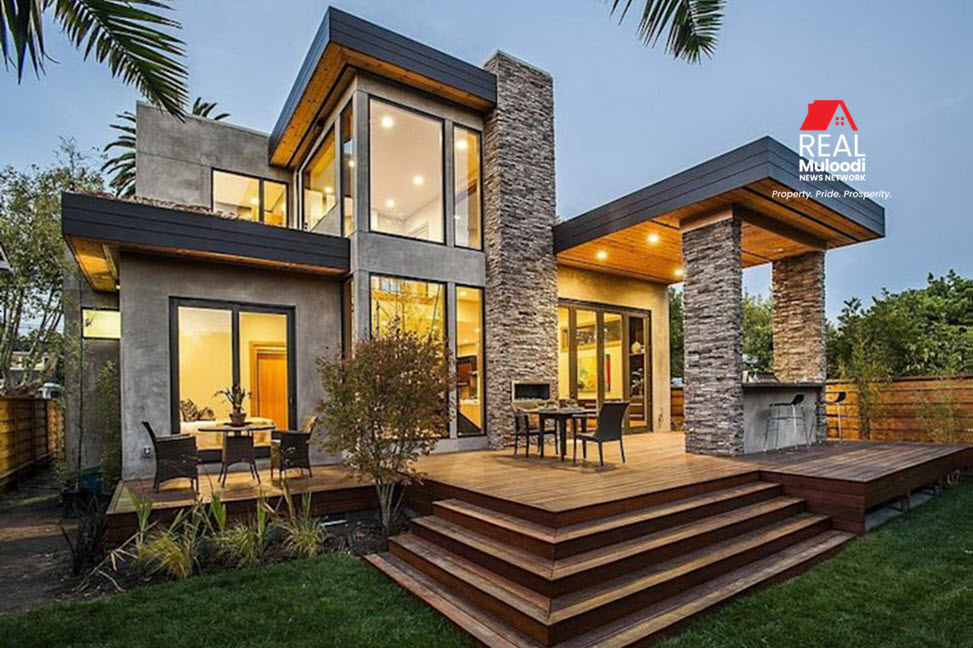UGANDA, Kampala | Real Muloodi News | A flat roof is a roof that is almost level. However, whilst they are described as ‘flat’, almost all flat roofs have some fall, or ‘pitch’ to ensure that rainwater can run off to the lowest side. The pitch of a flat roof is can be anywhere up to 10 degrees, but is typically between one and three degrees.
A flat roof is an ancient form of roofing used primarily in arid climates. The almost-level roof allows it to be used as a living space, and keeps the house cool in the summer.
This kind of roofing is standard with commercial buildings, but it is also found on some residential homes, and we associate them with Persian, Arabian, and Egyptian architectural styles.
According to Darwin Mukiza, Civil Engineer at DaWinÇi Impressions Ltd, some people prefer flat roofs because they are less expensive and simple to install. For example, constructing using flat roofs trusses is more manageable than traditional hip roofs, so you do not have to worry about your contractors running into an issue with the project.
Further, if there are any problems it is just as easy to repair a flat roof as it is to construct it. Therefore, the cost to repair or re-coat a flat roof is affordable compared to other roofing systems.
However, even the most well-crafted flat roofing materials will not perform correctly if they are installed poorly. Flat roofs are highly vulnerable to leaks due to their near non-existent pitch. Therefore, it’s vitally important that any flat roof is installed with precision, and that post-installation it is well maintained.
There is nothing more frustrating than water stains on your roof or walls, or bubbling and peeling paint due to water leakage.

There are a few significant reasons these flat roofs fail from time to time, and we will go over some causes and solutions to these failures.
What Causes Leaks in Flat roofs?
Clogged Drains or Gutters
Your flat roof depends on its drains and gutters to divert water away. When your gutters become clogged with debris such as leaves, the water is left to stand still on the roof, causing leakage. The longer water is allowed to remain on your roof, the greater the chances that it will lead to damaging leaks. The best way to prevent debris buildup is to trim any overhanging tree branches and clean up any debris regularly to avoid it piling up and blocking the drains and gutters.
Large Rooftop Units
Be aware that ponding (water that remains on the roof for longer than 48 hours following precipitation) is more likely to occur around large rooftop units such as air conditioners and water tanks. The weight of such units can sometimes deflect the structure of the underlying roofing supports. This can lead to the formation of a ponding area.
Roof Penetrating Structures
As with sloped shingle roofs, flat roofs are vulnerable to leaks around areas where a structure rises up through the roof’s surface. These structures may include plumbing vents, gas lines, pipes, and other building elements.

Solutions
Roof and Drain Cleaning
Make sure you regularly clean your flat roof, but be careful not to push debris down the drains.
You should inspect the drainage system for clogging preventing water from draining off your roof. Knock on the downpipes and listen; if the pipe sounds dull, then there is some debris stuck inside.
Using Oversized Gutters and Downpipes
Civil Engineer Darwin Mukiza recommends using oversized concentrated drains and gutters to help prevent clogging caused by debris.
The downpipe must also be large enough to prevent blockages, says Mukiza.
Install Flashing
Adding flashing around chimneys and vents will help to prevent leaks.
Waterproof Mixture or a Membrane
Using a waterproof mixture or a waterproof membrane on the slug of your rooftop helps prevent water penetration on a flat roof.
If you have real estate news that you would like featured on Real Muloodi News Network, contact us via email at support@realmuloodi.co.ug
READ MORE LIKE THIS:



